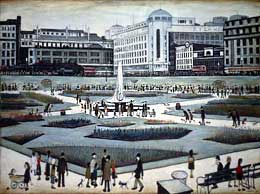
Laurence Stephen Lowry was an English artist. His drawings and paintings mainly depict Pendlebury, Greater Manchester as well as Salford and its vicinity.

Manchester City Centre is the central business district of Manchester, England, within the confines of Great Ancoats Street, A6042 Trinity Way, and A57(M) Mancunian Way, which collectively form an inner ring road. The City Centre ward had a population of 17,861 at the 2011 census.
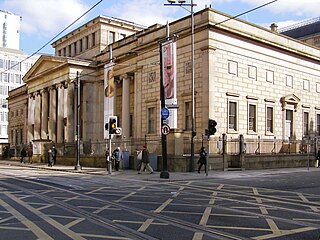
Manchester Art Gallery, formerly Manchester City Art Gallery, is a publicly owned art museum on Mosley Street in Manchester city centre, England. The main gallery premises were built for a learned society in 1823 and today its collection occupies three connected buildings, two of which were designed by Sir Charles Barry. Both of Barry's buildings are listed. The building that links them was designed by Hopkins Architects following an architectural design competition managed by RIBA Competitions. It opened in 2002 following a major renovation and expansion project undertaken by the art gallery.

Pierre Adolphe Valette was a French Impressionist painter who spent most of his career in England. His most acclaimed paintings are urban landscapes of Manchester, now in the collection of Manchester Art Gallery. Today, he is chiefly remembered as L. S. Lowry's tutor.

Piccadilly Gardens is a green space in Manchester city centre, England, on the edge of the Northern Quarter.

The Lowry is a theatre and gallery complex at Salford Quays, Salford, Greater Manchester, England. It is named after the early 20th-century painter L. S. Lowry, known for his paintings of industrial scenes in North West England. The complex opened on 28 April 2000 and was officially opened on 12 October 2000 by Queen Elizabeth II.

Piccadilly Gardens is a tram stop in Zone 1 of Greater Manchester's Metrolink light rail system. It is located beside Piccadilly Gardens in Manchester city centre, and serves both as a transport hub, and interchange station.

The Culture of Manchester is notable artistically, architecturally, theatrically and musically. Despite being the 5th largest city in the United Kingdom by population and the second largest conurbation, Manchester has been ranked as the second city of the United Kingdom in numerous polls since the 2000s (decade), with an influential culture scene helping to elevate Manchester's importance in the national psyche. This has helped the city's population grow by 20% in the last decade, and made the universities the most popular choices for undergraduate admission.
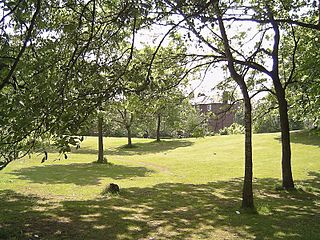
Platt Fields Park is a large public park in Fallowfield, Manchester, England which is home to Platt Hall. Fallowfield lies to the south and Wilmslow Road runs along its eastern edge. Its north-eastern corner is close to the start of the Curry Mile.
The Manchester Academy of Fine Arts (MAFA) was founded in 1859 by artists eager to promote art and education. It was originally based in the building on Mosley Street which is now Manchester Art Gallery where annual exhibitions and classes were held.

Peel Park is a public urban park in Salford, Greater Manchester, England, located on the flood plain of the River Irwell below Salford Crescent and adjacent to the University of Salford. It was the first of three public parks to be opened on 22 August 1846, for the people of Manchester and Salford, paid for by public subscription. The park was the main public venue for the 1851 royal visit of Queen Victoria to Manchester and Salford and has been the subject of a number of paintings by the Salford artist, L.S. Lowry.
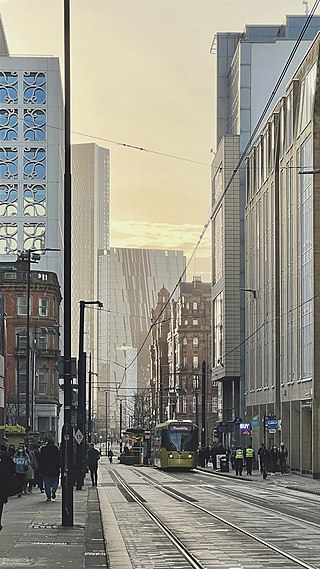
Mosley Street is a street in Manchester, England. It runs between its junction with Piccadilly Gardens and Market Street to St Peter's Square. Beyond St Peter's Square it becomes Lower Mosley Street. It is the location of several Grade II and Grade II* listed buildings.

Manchester School of Art in Manchester, England, was established in 1838 as the Manchester School of Design. It is the second oldest art school in the United Kingdom after the Royal College of Art which was founded the year before. It is now part of Manchester Metropolitan University.
In the final half of the 19th century Manchester's reputation as a financial and commercial centre was boosted by the unprecedented number of warehouses erected in the city centre. In 1806 there were just over 1,000 but by 1815 this had almost doubled to 1,819. Manchester was dubbed "warehouse city". The earliest were built around King Street although by 1850 warehouses had spread to Portland Street and later to Whitworth Street. They are direct descendants of the canal warehouses of Castlefield.

The Rylands Building is a Grade II listed building and former department store on Market Street in Manchester, England. It is situated in the Smithfield conservation area, which was known for its markets and textile warehouses, close to the Piccadilly area of Manchester city centre.

Coming from the Mill is an oil-on-canvas painting created in 1930 by British painter Laurence Stephen Lowry.

The following is a timeline of the history of the city of Manchester in north west England.
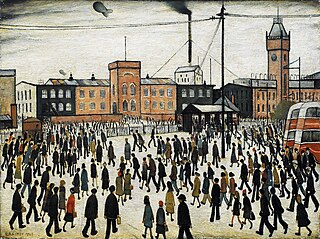
Going to Work is a 1943 oil painting by the English artist L. S. Lowry.

Industrial Landscape is the title given to each of a series of oil paintings by the English artist L. S. Lowry, painted over a number of years between 1934 and 1955.
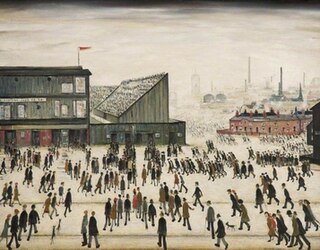
Going to the Match is a painting by British painter L. S. Lowry from 1953, depicting football fans and Burnden Park, the then home of Bolton Wanderers Football Club. Lowry had previously painted a different Going to the Match in 1928, which depicted fans outside a rugby ground, however, the 1953 painting has gained more fame over the years and become synonymous with the phrase Going to the Match. The 1953 picture sold at auction for £7.8 million in 2022, whereas the 1928 painting was valued at between £2 and £3 million in 2021.
